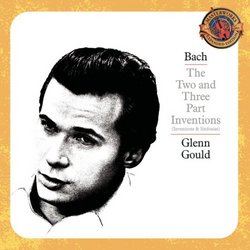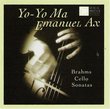| All Artists: J.S. Bach, Gould Title: 2 & 3 Part Inventions Members Wishing: 0 Total Copies: 0 Label: Sony Original Release Date: 1/1/1993 Re-Release Date: 3/9/1993 Genre: Classical Styles: Historical Periods, Baroque (c.1600-1750), Modern, 20th, & 21st Century, Symphonies Number of Discs: 1 SwapaCD Credits: 1 UPCs: 074645259628, 5099705259627 |
Search - J.S. Bach, Gould :: 2 & 3 Part Inventions
 | J.S. Bach, Gould 2 & 3 Part Inventions Genre: Classical
Better known among pianists and the public as the Two and Three Part Inventions, these little gems were written by Bach as instruction in proper keyboard and compositional technique for his son, Wilhelm Friedemann. True, t... more » |
Larger Image |
CD DetailsSynopsis
Amazon.com essential recording Better known among pianists and the public as the Two and Three Part Inventions, these little gems were written by Bach as instruction in proper keyboard and compositional technique for his son, Wilhelm Friedemann. True, the music may be in only two or three parts, but what parts! And as any pianist will tell you, this is not easy music to play, since Bach demands absolute equality between the various music lines. It's the sort of thing Gould loved above all else, and he simply has a blast with these pieces, as will you. Vintage Bach, vintage Gould. --David Hurwitz Similarly Requested CDs
|
CD ReviewsOne of the best recordings of Bach ever made... 11/28/2000 (5 out of 5 stars) "...and that's even accounting for all of the background noise that the previous reviewer mentioned. The noise, of course, consists mostly of Gould's humming along with the music and, while at times annoying, it does make you feel like you're there with Gould in the recording studio.As for the music, well, it's brilliant. All of these inventions are little gems, some of the best stuff Bach wrote in my opinion, and Gould is definitely up to the task. Gould's technique shines all over, especially in the Invention #13 in A minor, which he plays much faster than any other recording I've heard (the piece was featured in one of the bits in the film '32 Short Films about Glenn Gould', by the way). Through his immaculate playing Gould brings out every note clearly, managing to carry the fugal themes continuously as they cross over and under each other. Yet unlike in his wierd and often cold recordings of Mozart and Beethoven, Gould also manages to evoke a range of emotions, even coming close to pathos in the last and longest invention. Anyone who says Bach is soulless should listen to this.Definitely a must for any Bach fan." As fresh as it gets 04/16/1999 (5 out of 5 stars) "I haven't heard of any other performance of these little songs that is even close to what Gould is able to show us here. He is truly amazing in the way he nurtures and guides these pieces through their delicate windlings. OK, ok a lot of people out there might not approve of Gould's playing in general, but listen to this one! Sweet, tender and ravishing! I challenge anyone to bring me a better recording. A must have!" Bach, with quirks of Gould Mark Swinton | 02/01/2002 (4 out of 5 stars) "Glenn Gould: one of the most intriguing and original musicians of any time. The film-documentaries and books about him all show him sitting at a battered-looking grand piano, on a similarly bedraggled chair rather than a piano stool, in what can only be described as a ridiculous posture. His recordings of the complete keyboard works (other than organ works) of Johann Sebastian Bach give testament to further quirks of his playing: he grunts and hums along with himself, picking out strands of the melody and reinforcing them vocally in a manner that can be annoying but is clearly done for very personal reasons. Additionally, he has his own ideas about tempo, dynamics and articulation, such as is guaranteed to make purists shudder. An example from this recording of the "Two- and Three-Part Inventions and Sinfonias" is the breakneck speed with which he takes the C major Sinfonia, after the almost plodding pace of the preceding C major Invention.Yet, if the listener can get past these idiosyncrasies, s/he will find that at the core, Gould was an outstanding pianist beyond any doubt. He may play some pieces so fast that they go by in under a minute, and his humming may detract from the emotional effect that people hope to gain by listening to this music, but there is not a note out of place - and many a pianist may tell you that that can be hard to achieve in much of Bach's music. Opinions are bound to differ, but when I listen to this recording I often sense that Gould is letting his joy in this music shine through above all else - it matters little that he reinterprets it in his own way; that is arguably the case when any musician plays from a score that was, after all, written by another musician.There have been numerous recordings of Bach's keyboard works, and many are far superior in terms of the quality of instrument used, or performance practice adopted by the player. (Angela Hewitt's recordings on Hyperion are often the most praised, in no small part because of her outstanding accuracy and beauty of tone.) Yet of all I've heard, few come close to the unique personality of Gould; it is most strange, yet in a way most magical to hear. This programme of the Inventions and Sinfonias - exquisite miniatures rather than an extended work - is ideal in which to hear Gould's deeply personal Bach playing.
Unusual and interesting..." |

 Track Listings (30) - Disc #1
Track Listings (30) - Disc #1
![Delibes - Lakmé / Mesplé, Burles, Soyer, Millet, Opéra-Comique, Lombard [highlights]](https://nationalbookswap.com/cd//m/63/8663/6008663.jpg)





